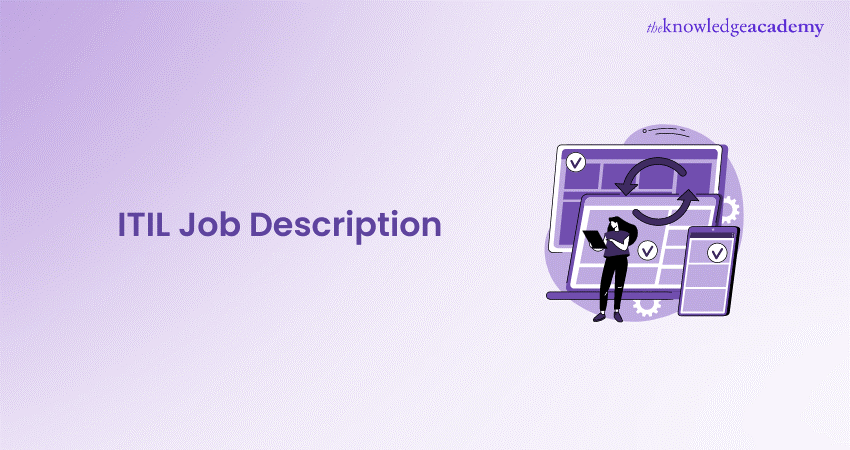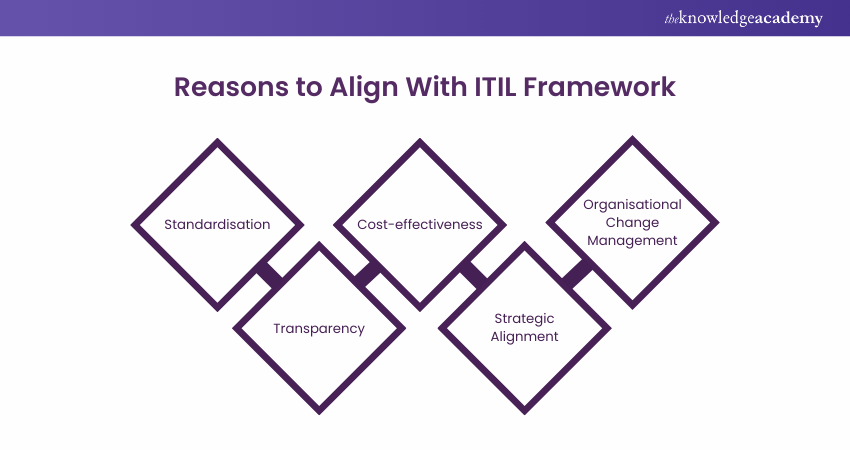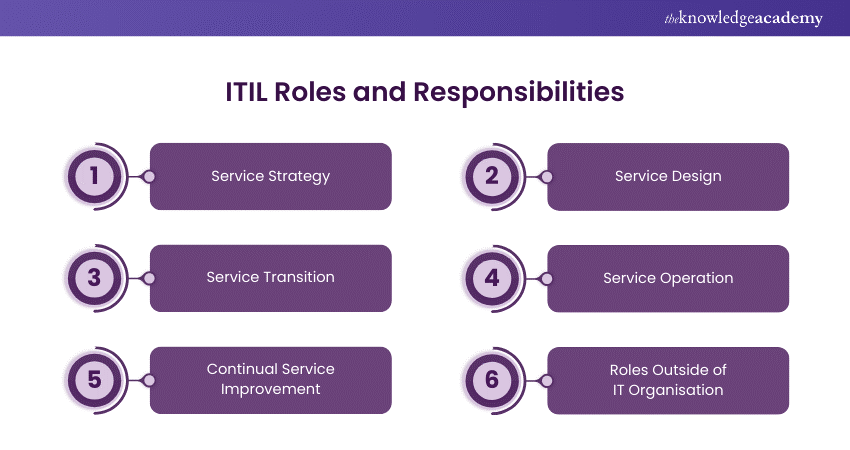We may not have the course you’re looking for. If you enquire or give us a call on +44 1344 203999 and speak to our training experts, we may still be able to help with your training requirements.
We ensure quality, budget-alignment, and timely delivery by our expert instructors.

In today’s rapidly evolving landscape, Information Technology (IT) stands as the beating heart of innovation. Its roots reach far and wide, weaving through our lives with the magic of digital transformation. From virtual art studios that spark creativity to data-driven decision-making that fuels precision, IT transcends boundaries, creating a limitless world where dreams are just a click away.
Amid this seismic expansion, ITIL (Information Technology Infrastructure Library) and its professionals take centre stage. If you’re embarking on a journey in this field, understanding the nuances of an ITIL Job Description becomes your compass to success. These professionals optimise processes, elevate service delivery, and play a pivotal role in maintaining IT excellence. Join us as we delve into the responsibilities, skills, and impact that define the ideal ITIL role.
Table of Content
1) What is ITIL?
2) ITIL Job Roles
a) Process Owner
b) Process Manager
c) Process Practitioner
d) Service Provider
3) ITIL Roles and Responsibilities in Different Sectors
4) ITIL Roles outside of the IT organisation
5) Conclusion
What is ITIL?
The Information Technology Infrastructure Library (ITIL) is a comprehensive framework and set of practices designed for IT activities, encompassing IT Service Management (ITSM) and IT Asset Management (ITAM). Its primary focus is on aligning IT services with the evolving needs of the enterprise.
ITIL offers best practices to ensure the effective management of IT services, enhance support, and maintain high service levels. By following ITIL guidelines, organisations can achieve greater efficiency, reliability, and consistency in their IT operations, ultimately driving business success and customer satisfaction.
Here are a few reasons for a company to align their IT processes with the ITIL framework:

Standardisation
ITIL aims to create predictable IT environments by establishing consistent practices. This helps manage risks, solve problems, and streamline processes.
Transparency
Implementing ITIL standards improves visibility into IT costs and operations. It also bridges the gap between IT and other departments, allowing IT administrators to be both front-end business partners and back-end support.
Cost-effectiveness
The ITIL framework helps organisations optimise their hardware and software resources efficiently.
Strategic Alignment
ITIL seeks to align business operations with IT. Effective communication ensures that business strategies translate into technical requirements.
Organisational Change Management
The ITIL foundation includes best practices for ITIL change management. These guidelines enable IT professionals to release changes without interrupting service.
ITIL Job Roles
In ITIL, roles are defined to assign responsibilities for various processes and activities within detailed process definitions. These roles help ensure effective management and accountability. The job roles are decided through a RACI network where RACI represents:
a) Responsible
b) Accountable
c) Consulted
d) Informed
The most prominent ITIL job roles are listed below:
Process Owner
The Process Owner’s main responsibility is to make sure the process they own operates as intended. The Process Owner must ensure that the agreed-upon process meets its original goals and objectives and is executed according to the established specifications.
Here are some Process Owner responsibilities:
a) Process-related Communications: The Process Owner is responsible for raising awareness about the process and communicating any associated changes.
b) Resource Provision: The Process Owner ensures that necessary resources are available for process activities. They also ensure that everyone involved in the process understands their roles.
c) Improvement Activity: Identifying improvement opportunities and facilitating their implementation is a crucial role for any Process Owner. They also address process issues as they arise.
d) Periodical Process Reviews: Process Owners should conduct regular reviews to keep the process up-to-date and ensure it is being invoked correctly.
e) Periodical Process Audits: The process may need to be audited periodically to ensure compliance with internal or external requirements. In this context, the Process Owner establishes process-based policies and ensures compliance.
Process Manager
Procedure supervisors should collaborate with the Process Owner to define how activities will be carried out and are responsible for ensuring they are executed accordingly. Depending on the organisation's size, the Process Manager might also be the Process Owner.
Additional activities for Process Managers include:
a) People Management: Recruiting the necessary personnel to execute the process activities and managing the assembled team.
b) Process Management: Ensuring the process operates smoothly and effectively on a daily and monthly basis.
c) Performance Reporting: Monitoring the process to verify its effectiveness and reporting on its performance.
d) Process Improvement: Collaborating with the Process Owner to identify and implement enhancements to the process.
Process Practitioner
Process Practitioners are the key individuals responsible for executing the core activities of a process. They play a crucial role in ensuring that the process functions as intended, following the established procedures and guidelines.
a) Collaboration: Process Practitioners work closely with service users, clients, line management, and colleagues. Their goal is to ensure that the process is effective and meets the needs of all stakeholders.
b) Understanding Role Context: Process Practitioners should have a clear understanding of how their role fits within both the IT organisation and the broader parent organisation. This context helps them appreciate the value they provide.
Service Owner
Service Owners are primarily responsible for initiating new IT services, transitioning them into production, and oversee their ongoing maintenance. They ensure that their service is delivered within the agreed service as specified in Service Level Agreements (SLAs). Additionally, they are accountable to the customer throughout the ITIL service lifecycle.
The IT Comms Services Manager or network manager is an example of a Service Owner. These are the key features of this role:
a) Role Responsibilities: As the Service Owner for all communication channels within the business, this manager must ensure these channels meet business requirements and stay updated as the business evolves.
b) Issue Resolution: Any issues related to the communication channels are directed to the Service Owner, who must collaborate with their team to resolve them efficiently.
c) Accountabilities: Like a Process Owner, the Service Owner handles changes, identifies and implements improvements, and communicates updates to keep stakeholders informed.
d) Regular Review and Audit: The Service Owner must regularly review and audit their services to ensure they meet business needs and comply with internal and external requirements.
Explore our ITIL Courses to improve your IT service management skills. Register now to advance your career!
ITIL Roles and Responsibilities in Different Sectors
In the context of ITIL, roles involve specific responsibilities and activities assigned to teams or individuals within a process. It’s common for one person or team to take on multiple roles—for example, handling both incident management and ITIL problem management roles and responsibilities.
Here are some of the most important ITIL roles vital for different sectors:

1) Service Strategy
Service Strategy offers guidance on prioritising a service provider’s investments in services. Key roles within Service Strategy include:
a) IT Steering Group (ISG): This group, comprising of senior management from both business and IT, sets the direction and strategy for IT services. The ISG aligns business and IT strategies and prioritises service development projects.
b) Financial Manager: An individual in this ITIL role is responsible for managing the accounting and budgeting requirements of an IT service provider.
c) Service Portfolio Manager: In collaboration with the IT Steering Group, this role decides the strategy to serve customers and develops the service provider's offerings and capabilities.
2) Service Design
The broad umbrella of service design includes the following roles:
a) Service Catalogue Manager: This role involves maintaining an accurate and up-to-date service catalogue.
b) Service Level Manager (SLM): This involves negotiating service level agreements, ensuring compliance, and monitoring service levels. Also, handles operational level agreements and underpinning contracts.
c) Service Owner: Delivers a specific service within agreed service levels. Often collaborates with the Service Level Manager during negotiations.
d) Service Design Manager: Develops high-quality, secure and resilient designs for new or improved services (Including maintaining design documentation).
e) Capacity Manager: Ensures services and infrastructure meet agreed capacity and performance targets cost-effectively. Plans for short, medium, and long-term business requirements.
f) Availability Manager: Defines, analyses, plans, measures, and improves IT service availability. Ensures alignment with agreed service level targets.
g) IT Service Continuity Manager: Manages risks impacting IT services, ensuring minimum service levels during disasters. Plans for service recovery.
h) IT Security Manager: Safeguards confidentiality, integrity, and availability of assets, information, and IT services. Has a broader organisational scope beyond IT.
i) Compliance Manager: Ensures adherence to standards, guidelines, and legal requirements. Maintains consistent practices.
j) IT Architect: Designs the future technological landscape, considering service strategy and emerging technologies.
k) Applications Analyst/Architect: Designs required applications, specifying technologies, application architectures, and data structures.
3) Service Transition
Various roles fall under this significant ITIL Job Description:
1) Change Manager: This role authorises and documents changes in the IT infrastructure and its components. It involves the Change Advisory Board (CAB).
2) Change Advisory Board (CAB): This is a group that advises the Change Manager along with assessing, prioritising, and scheduling changes. It includes representatives from IT Service Provider and third parties.
3) Change Owner: This role backs a change and holds the budget for implementation. It’s often identical to the Request for Change (RFC) initiator.
4) Emergency Change Advisory Board (ECAB): This is a subset of the CAB and makes decisions regarding high-impact emergency changes.
5) Project Manager: This plans and coordinates resources for major releases.
6) Test Manager: The Test Manager ensures that deployed releases and the resulting services meet customer expectations. This involves the verification that IT operations can support the new service.
4) Service Operation
Service Operation focuses on the principles, processes and operational activities that enable organisations to successfully manage their product and service performance.
Some of the Key roles in the Service Operation include:
a) 1st Level Support: This role is responsible for registering and classifying received incidents and making immediate efforts to restore failed IT services. First Level Support also processes Service Requests and informs users about the status of their incidents at agreed intervals.
b) 2nd Level Support: This team handles incidents that First Level Support cannot resolve. If necessary, they may request external support from software or hardware manufacturers. Their primary goal is to restore failed IT services as quickly as possible.
c) 3rd Level Support: This role, typically located with hardware or software manufacturers, is engaged by Second Level Support when needed to resolve incidents.
5) Continual Service Improvement
This job description includes the following roles:
a) CSI Manager: The Continual Service Improvement (CSI) Manager oversees the enhancement of ITIL® 4 roles and involves continuously measuring the service provider's performance. This also involves designing improvements to processes, services and infrastructure to boost efficiency and cost-effectiveness.
b) Process Manager: The Process Manager plans and coordinates all activities related to process management. They support stakeholders involved in managing and improving processes, particularly the Process Owners.
c) Process Owner: A Process Owner ensures that a process is fit for its intended purpose. Their responsibilities include sponsoring, designing, and continuously improving the process and its metrics.
This role is often assigned to staff holding major Service Management positions (e.g., Incident Manager).
Elevate your IT governance knowledge! Enroll in our COBIT® Foundation course today and gain essential skills for effective management.
ITIL Roles outside of the IT organisation
Customers and Service Users represent two vital ITIL roles outside the IT organisation. The customer of an IT service provider establishes and decides on service-level objectives.
Meanwhile, a service user is an individual who uses one or more IT services daily. It's important to distinguish between these two roles because while service users directly interact with IT services, not all customers do.
Equip yourself with the best IT service strategies through our Certified IT Service Manager (CITSM) Certification – Sign up now!
Conclusion
Understanding the ITIL Job Description, including its roles, responsibilities and skillsets, is essential for effective IT Service Management. Mastery of these elements ensures seamless operations, improved service delivery, and alignment with business objectives. We hope this blog guides you down the path of success in the ITIL framework.
Looking to learn about ITIL framework? Sign up for our ITIL® 4 Foundation Certification now!
Frequently Asked Questions
What are the 4 Ps of service strategy?

The 4 Ps of the service strategy are Perspective, Position, Plan and Pattern
What is the ITIL life cycle?

ITIL Service Lifecycle is a framework defined in ITIL v3 for managing a product or service throughout its lifecycle. It consists of five stages: Service Strategy, Service Design, Service Transition, Service Operation and Continual Service Improvement
What are the Other Resources and Offers Provided by The Knowledge Academy?

The Knowledge Academy takes global learning to new heights, offering over 3,000 online courses across 490+ locations in 190+ countries. This expansive reach ensures accessibility and convenience for learners worldwide.
Alongside our diverse Online Course Catalogue, encompassing 19 major categories, we go the extra mile by providing a plethora of free educational Online Resources like News updates, Blogs, videos, webinars, and interview questions. Tailoring learning experiences further, professionals can maximise value with customisable Course Bundles of TKA.
What is The Knowledge Pass, and How Does it Work?

The Knowledge Academy’s Knowledge Pass, a prepaid voucher, adds another layer of flexibility, allowing course bookings over a 12-month period. Join us on a journey where education knows no bounds.
What are the Related Courses and Blogs Provided by The Knowledge Academy?

The Knowledge Academy offers various ITIL® Certification Training, including the ITIL® 4 Foundation Certification Course and ITIL® 4 Strategist Certification. These courses cater to different skill levels, providing comprehensive insights into ITIL® V3 Foundation.
Our IT Service Management Blogs cover a range of topics related to IT framework & services, offering valuable resources, best practices, and industry insights. Whether you are a beginner or looking to advance your IT Service Management skills, The Knowledge Academy's diverse courses and informative blogs have got you covered.
Upcoming IT Service Management Resources Batches & Dates
Date
 ITIL® 4 Foundation Certification Course
ITIL® 4 Foundation Certification Course
Wed 19th Feb 2025
Mon 24th Feb 2025
Wed 26th Feb 2025
Mon 3rd Mar 2025
Wed 5th Mar 2025
Mon 10th Mar 2025
Wed 12th Mar 2025
Sat 15th Mar 2025
Mon 17th Mar 2025
Wed 19th Mar 2025
Mon 24th Mar 2025
Wed 26th Mar 2025
Mon 31st Mar 2025
Wed 2nd Apr 2025
Sat 5th Apr 2025
Mon 7th Apr 2025
Wed 9th Apr 2025
Mon 14th Apr 2025
Wed 16th Apr 2025
Tue 22nd Apr 2025
Mon 28th Apr 2025
Wed 30th Apr 2025
Tue 6th May 2025
Sat 10th May 2025
Mon 12th May 2025
Wed 14th May 2025
Mon 19th May 2025
Wed 21st May 2025
Tue 27th May 2025
Mon 2nd Jun 2025
Wed 4th Jun 2025
Sat 7th Jun 2025
Mon 9th Jun 2025
Wed 11th Jun 2025
Mon 16th Jun 2025
Wed 18th Jun 2025
Mon 23rd Jun 2025
Wed 25th Jun 2025
Mon 30th Jun 2025
Wed 2nd Jul 2025
Mon 7th Jul 2025
Wed 9th Jul 2025
Sat 12th Jul 2025
Mon 14th Jul 2025
Wed 16th Jul 2025
Mon 21st Jul 2025
Wed 23rd Jul 2025
Mon 28th Jul 2025
Wed 30th Jul 2025
Mon 4th Aug 2025
Wed 6th Aug 2025
Sat 9th Aug 2025
Mon 11th Aug 2025
Wed 13th Aug 2025
Mon 18th Aug 2025
Wed 20th Aug 2025
Mon 25th Aug 2025
Mon 1st Sep 2025
Wed 3rd Sep 2025
Mon 8th Sep 2025
Wed 10th Sep 2025
Sat 13th Sep 2025
Mon 15th Sep 2025
Wed 17th Sep 2025
Mon 22nd Sep 2025
Wed 24th Sep 2025
Mon 29th Sep 2025
Wed 1st Oct 2025
Mon 6th Oct 2025
Wed 8th Oct 2025
Sat 11th Oct 2025
Mon 13th Oct 2025
Wed 15th Oct 2025
Mon 20th Oct 2025
Wed 22nd Oct 2025
Mon 27th Oct 2025
Wed 29th Oct 2025
Mon 3rd Nov 2025
Wed 5th Nov 2025
Sat 8th Nov 2025
Mon 10th Nov 2025
Wed 12th Nov 2025
Mon 17th Nov 2025
Wed 19th Nov 2025
Mon 24th Nov 2025
Wed 26th Nov 2025
Mon 1st Dec 2025
Wed 3rd Dec 2025
Mon 8th Dec 2025
Wed 10th Dec 2025
Sat 13th Dec 2025
Mon 15th Dec 2025
Wed 17th Dec 2025






 Top Rated Course
Top Rated Course



 If you wish to make any changes to your course, please
If you wish to make any changes to your course, please


